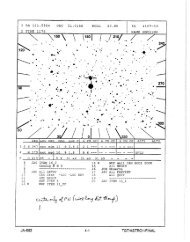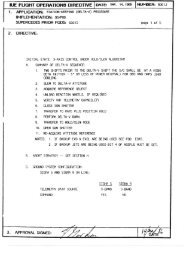The FUSE Archival Data Handbook - MAST - STScI
The FUSE Archival Data Handbook - MAST - STScI
The FUSE Archival Data Handbook - MAST - STScI
You also want an ePaper? Increase the reach of your titles
YUMPU automatically turns print PDFs into web optimized ePapers that Google loves.
was uploaded to the IDS before each HIST observation. <strong>The</strong> SIA table was a buffer made up of<br />
512 rectangles. <strong>The</strong> size of each rectangle was 2048 pixels in X and 16 pixels in Y . Thus, the<br />
512 elements of the SIA table constitute an 8×64 image which spans the 16384×1024 elements<br />
of the detectors. <strong>The</strong> SIA table specifies which of these rectangles should be saved (mask bit<br />
set “on”), i.e., if the IDS received a photon event from the detector whose (X, Y ) coordinates<br />
map to a location in an active rectangle, then that photon event is stored by incrementing a<br />
counter in a histogram bin at the specified binning. <strong>The</strong> default histogram binning size was<br />
1×8 (X, Y ) detector pixels. <strong>The</strong> default SIA table specified storage of a region around the aperture<br />
containing the target, and required ∼20 MB of storage for an orbit’s worth of exposures.<br />
Note that in HIST mode, only data taken through the science aperture were recorded. Because<br />
Doppler compensation was not performed on-board, HIST exposures times were kept short to<br />
avoid losing spectral resolution and minimize smearing from thermal motions. Typical HIST<br />
exposure times were ∼ 400 s. More information can be obtained in the Instrument <strong>Handbook</strong><br />
(2009.<br />
2.6 <strong>FUSE</strong> Mission Short Biography<br />
A series of events impaired optimal use of the <strong>FUSE</strong> spacecraft and impacted the data acquisition<br />
and processing during those times. A list of the most significant events affecting <strong>FUSE</strong><br />
data quality is given in Table 2.3 where Column (1) lists the chronology of these events since<br />
the <strong>FUSE</strong> launch; Column (2) gives a brief description of the events that took place; and Column<br />
(3) points to Notes to the table. A complete listing of such events can be found in the<br />
Instrument <strong>Handbook</strong> (2009).<br />
Table 2.3: Significant Events<br />
Date Event Notes<br />
24 June 1999 Launched · · ·<br />
12 December 1999 LiF1 Focus Finalized (1); (3)<br />
16 March 2000 LiF2, SiC1,2 Focus Finalized (1); (3)<br />
25 November 2001 Yaw RWA failed (2)<br />
10 December 2001 Pitch RWA failed (2); Science operations suspended<br />
February 2002 Two-wheel mode begins Observations resumed<br />
03 February 2003 Segment 2A HV confined (4)<br />
31 July 2003 Yaw IRU-B failed (2); Gyroless control mode used<br />
27 December 2004 Roll RWA failed (2); Science operations suspended<br />
March 2005 One-wheel mode begins Observations resumed<br />
12 July 2005 LiF2 made default guiding channel (3)<br />
12 July 2007 Skew RWA failed End of <strong>FUSE</strong> pointed observations<br />
18 October 2007 Decommissioning End of <strong>FUSE</strong> mission<br />
12




